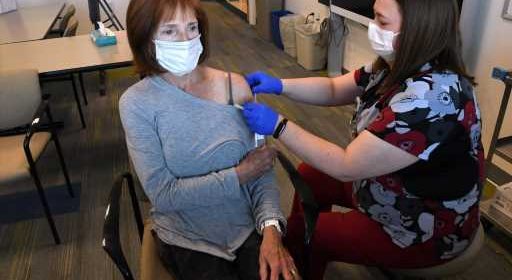Colorado likely to have quiet COVID fall, reports say

Barring a variant with the wrong combination of mutations, Colorado should have a relatively quiet fall when it comes to COVID-19, the state’s modeling team projected.
The latest report from the team, released Thursday, Oct. 6, showed hospitalizations declining slowly over the next 12 weeks, with the caveat that a new variant could throw that off. It’s also possible that the number of severe illnesses will remain essentially on a plateau, said Bailey Fosdick, a member of the team and associate professor of biostatistics and informatics at the Colorado School of Public Health.
“Over the next 12 weeks, we’re pretty confident things will stay low,” she said.
But that doesn’t mean people should treat the virus as a thing of the past, Fosdick said. It’s still a good idea to reduce your risk by staying up to date on vaccines, she said. The report estimated roughly one in 188 people are contagious now.
Hospitalizations have been bouncing around between 145 and 195 since late August, without a clear trajectory. On Tuesday afternoon, 165 people were hospitalized with COVID-19, down from 185 a week earlier. About two-thirds are receiving care primarily for the virus, according to data from the Colorado Department of Public Health and Environment, though it varies slightly from week to week.
The state health department recorded 3,982 new cases in the week ending Sunday, which was about 300 fewer than the previous week. An average of 5.1% of tests came back positive over the last seven days, which was slightly lower than a week earlier.
Virus concentrations in wastewater were relatively flat or trending down slightly in most of the state, with the exception of the San Luis Valley region, according to the report. That overlaps somewhat with the Centers for Disease Control and Prevention’s community risk levels, which are largely based on hospitalization trends. Almost all Colorado counties were at low risk, except for four at the medium level: Alamosa, Archuleta, Ouray and San Juan.
On the other hand, 46 of the 64 counties in Colorado have case levels that suggested “high” or “substantial” transmission, according to the CDC.
Projections for the country as a whole also show a relatively quiet fall for COVID-19 infections if everything stays the same. New variants are proliferating, but it’s not clear if any of them have characteristics that could cause another wave.
Nationwide, cases and hospitalizations have continued to trend down, though the number of people hospitalized is rising in the Northeast. An average of 379 COVID-19 deaths were reported each day, according to data from The New York Times. (Some may ultimately be attributed to other causes in the final death certificate data, but the vast majority of deaths with COVID in the first two years of the pandemic were ruled deaths from COVID.)
The picture overseas is less reassuring. In Europe, 15 countries reported increasing cases at the end of September. Hospitalizations had risen about 37% in the United Kingdom between Sept. 21 and Sept. 28, though they still remained at relatively low levels. That may matter because the United States generally followed a similar trajectory to the United Kingdom, with a delay of a few weeks.
The CDC estimates BA.5 still accounts for about 79% of cases nationwide, with BA.4.6 showing up in almost 14% and BF.7 in just under 5%. Variants will continue to evolve, Fosdick said, but the question is whether any of them are significantly more infectious, better at evading the immune system, or more virulent.
In Colorado, just under 90% of sequenced samples contained BA.5 as of Sept. 18. BA.4.6 was a distant second, found in about 6% of samples.
The modeling report estimated close to three-quarters of Coloradans likely have at least temporary immunity to BA.5, with a higher percentage unlikely to develop severe disease. Still, it’s a good idea to get your booster shot targeted to the current variant if you’re at least three months out from an infection, Fosdick said. It’s incredibly difficult to try to time your shot right before some future surge, and the booster should offer some protection even if a new variant unseats BA.5, she said.
“The best thing people can do is protect themselves today,” she said.
Subscribe to the bi-weekly newsletter to get health news sent straight to your inbox.
Source: Read Full Article